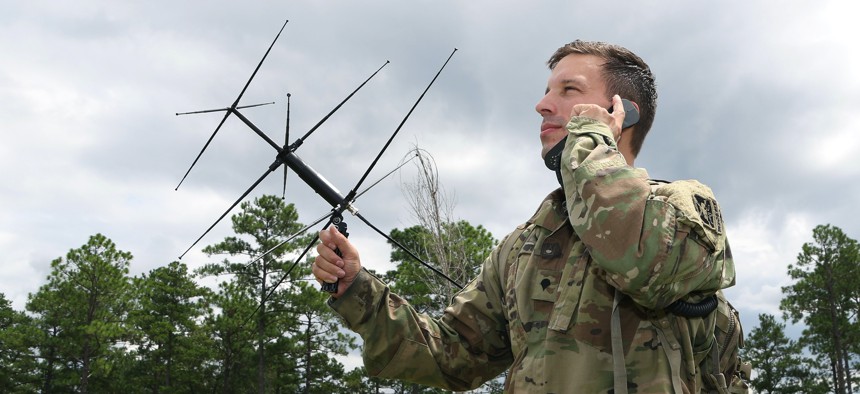
A student in the Special Forces Communications Sergeant course uses an AV-2125 satellite antenna with an AN/PRC-117G satellite radio during training. U.S. Army / / K. Kassens
We Need a Goldwater-Nichols Act for Emerging Technology
The 1986 law made joint experience a prerequisite for high rank. We must do the same for technological facility.
The U.S. military overcame inter-service friction to become the world’s best at joint operations in large part because Congress imposed legislation upon a Defense Department that could not or would not overcome the challenges on its own. Today, lawmakers should consider similar steps to help the military better grapple with and integrate rapidly changing technology.
Passed in 1986 after a contentious political fight and over DoD opposition, the Goldwater-Nichols Department of Defense Reorganization Act established unity of command through the combatant commanders. It also reserved half of joint duty assignments in grades above O-3 for joint-qualified officers — that is, those who have completed a program through a Joint Professional Military Education school and two years of joint assignments. The results speak for themselves: across the services, joint experience and education has for decades been a requirement for advancement to senior ranks.
Today, we face a problem of a similar scope and scale. The officer corps is highly qualified to meet the challenges it is currently preparing for. However, as we know from first-hand experience as the inaugural director of two artificial intelligence fielding organizations in the DoD and as the former Principal Deputy Under Secretary for Defense for Personnel and Readiness, today’s officers are woefully unprepared to integrate rapidly-changing technology into operating concepts, planning processes, weapon systems, or even daily business practices. DoD struggles to match commercial best practices when it comes to buying and fielding new systems. This is an endemic problem. Most organizations try to match old practices and bad habit patterns to new technology, rather than allowing new technology to help lead them to better and faster ways of operating. Data management practices are generally abysmal.
The cost of these practices is measured in misspent dollars, wasted time, and an incipient awareness that we are ceding our long-held military advantages to our competitors. Those consequences, however frustrating, are only a fraction of what may happen if the military fights a peer rival without more thoroughly embracing modern software practices and emerging technologies.
The Goldwater-Nichols Act, though hardly perfect, provides a useful roadmap for charting solutions to these dilemmas. The Joint Chiefs of Staff argue in their Vision and Guidance for Professional Military Education & Talent Management that developing effective military leaders requires integrating education with a talent management system that addresses, among other topics, emerging and disruptive technologies. To create this system, the National Security Commission on Artificial Intelligence recently recommended DoD create an emerging technology certification process that resembles today’s requirements for joint qualification. Military officers would earn their emerging technology certification by serving in emerging technology-focused fellowships, private sector talent exchanges, positions within government, and by taking courses focused on emerging and disruptive technologies. To encourage leaders to earn their certification, at least 50 percent of military personnel in positions that acquire new technologies, integrate or lead the integration of new technologies into operational units, develop organizational and operational concepts, or develop training and education programs will require certification. This should eventually include civilians and enlisted personnel as well.
Congress should also recognize that, much like when the Goldwater-Nichols Act was passed, it will be exceedingly difficult for the DoD to make these changes on its own. Major personnel policy changes require such prolonged and concentrated effort that in the past, competing priorities often derailed major reforms. Congressional leadership is needed, both to help align DoD priorities and to legislate changes to the U.S. Code.
Today, with the benefit of hindsight, Goldwater-Nichols’ wide-ranging improvements seem self-evident. Yet it is easy to forget just how strenuously many of the Department’s leaders initially resisted those changes. It took decades for a new culture to take root across the DoD, supported throughout by Congressional direction and oversight. We need a similar approach today as we move from an industrial-age, hardware-driven force to an information-age, software-driven, more risk-tolerant one. Twenty years from now, the fact that our military might have fully embraced emerging and disruptive technologies will never, by itself, guarantee victory in a future conflict. If, on the other hand, it does not adopt new technologies and adapt its operations accordingly, we will face an unacceptably high risk of defeat. There’s no time to waste.
John (Jack) Shanahan retired from the U.S. Air Force as a lieutenant general after a 36-year military career. His final assignment was as the inaugural Director of the U.S. Department of Defense Joint Artificial Intelligence Center.
Dr. Laura Junor is Director for the Institute for Strategic Studies at National Defense University. She previously served as the Principal Deputy Under Secretary of Defense for Personnel and Readiness.



